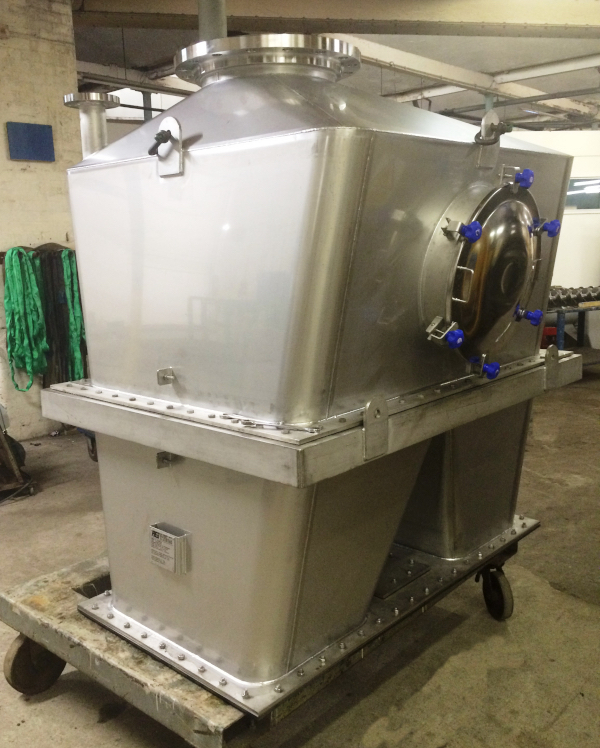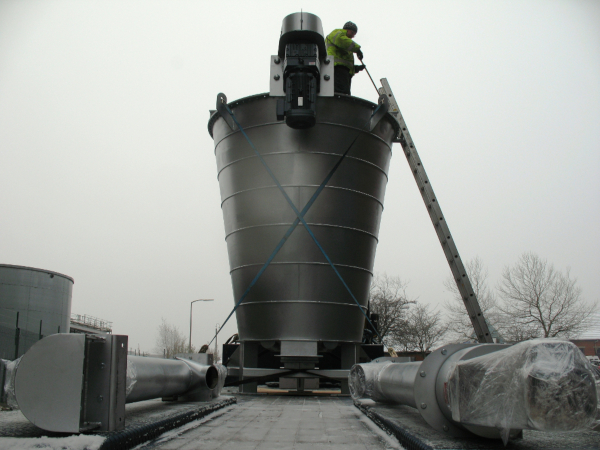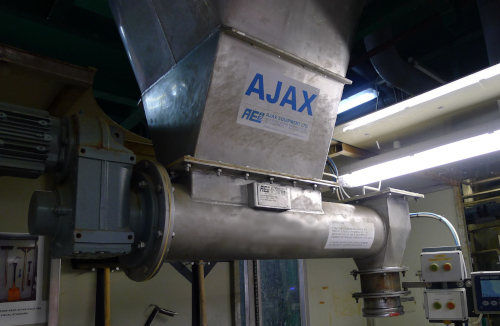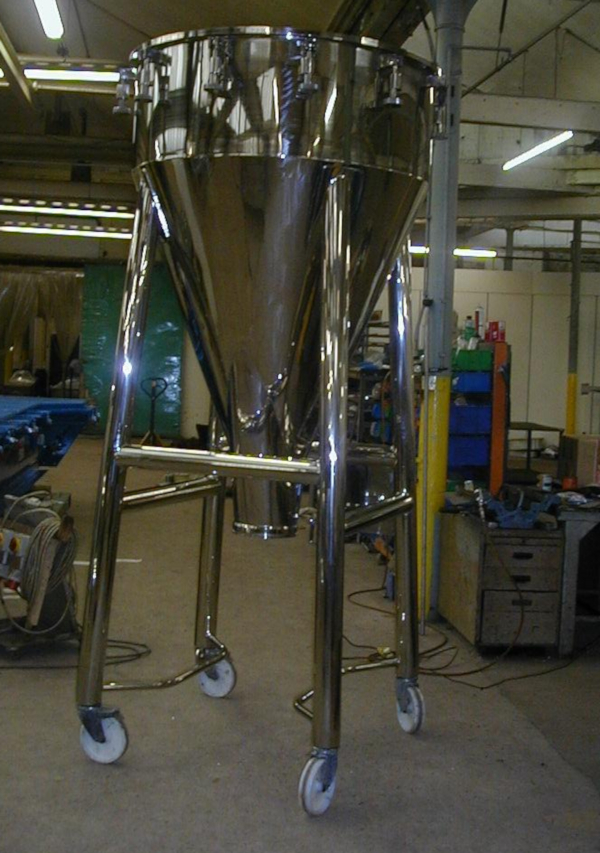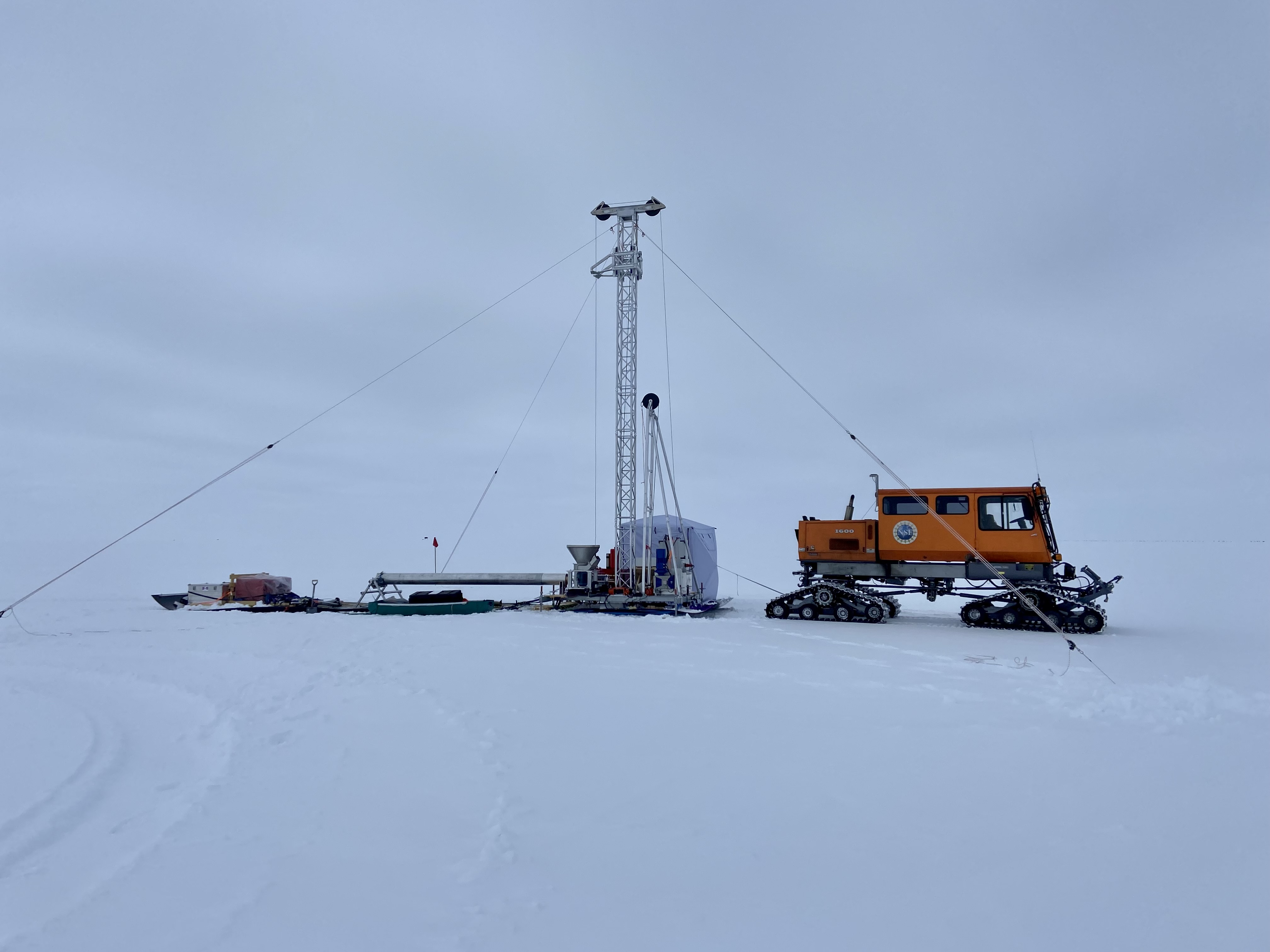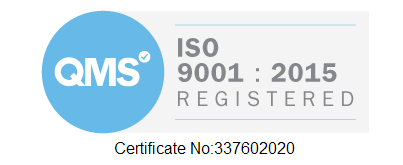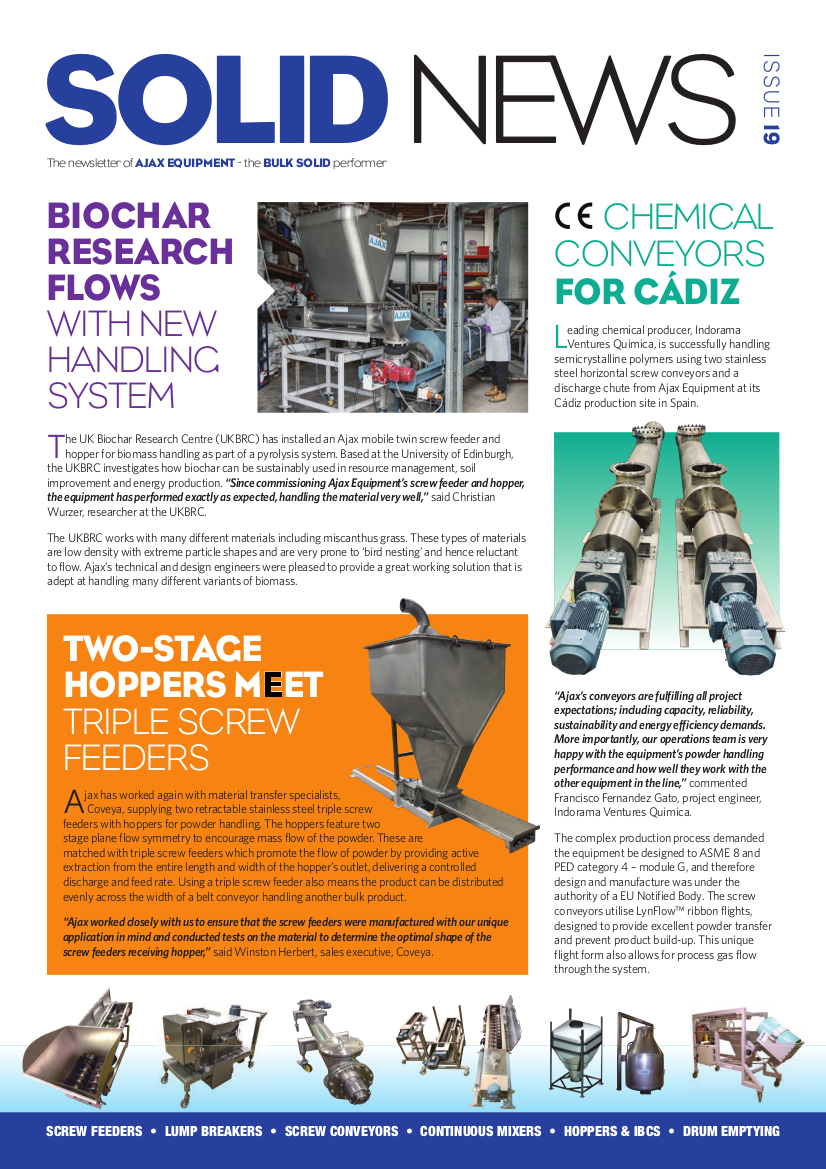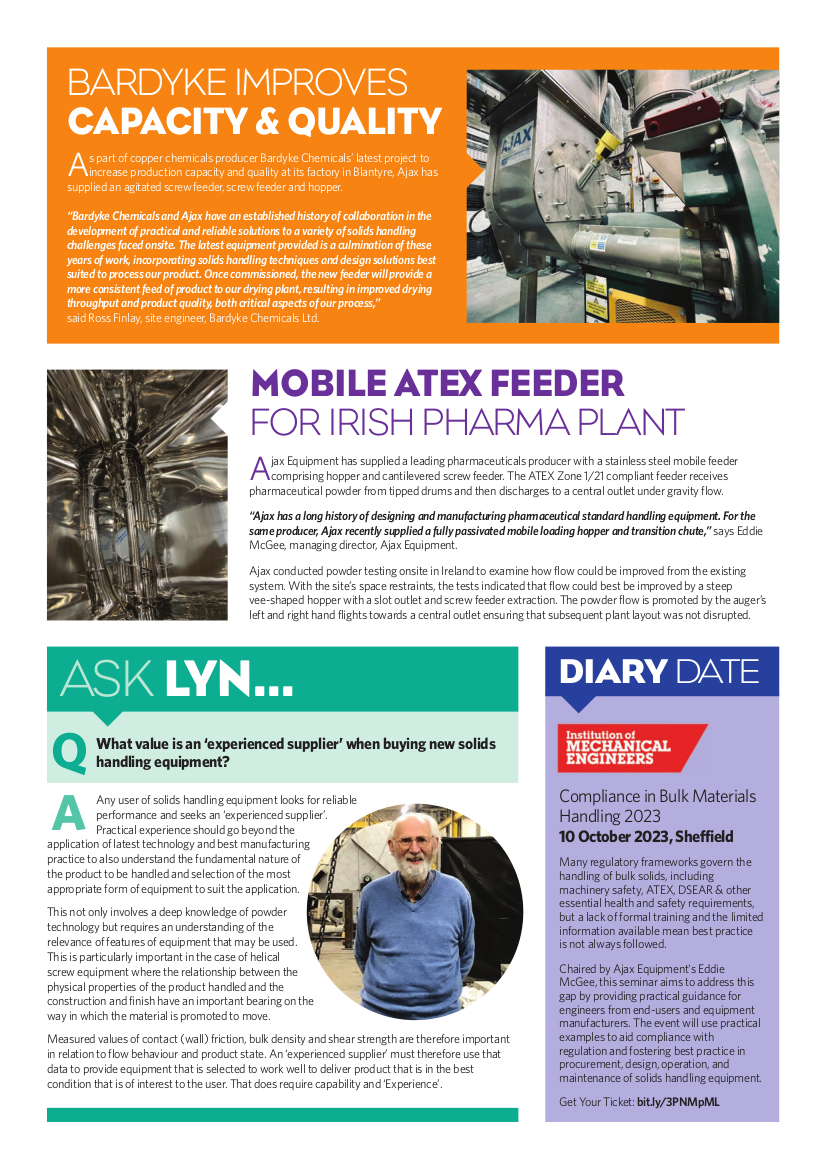AJAX Hopper Inserts
The Problem
The benefits of Mass Flow are well known,. Predictable 'First-in, first-out' storage, reliable, smooth and steady flow at a consistent density through smaller outlets, without erratic surges, 'arches', 'flushing' or dead regions of storage. Mass Flow therefore avoids many forms of operating problems in the storage of bulk materials, but a penalty is that steep hopper walls are needed to promote the slip of the contents on the contact surfaces. This choice of design invariably results in tall storage hoppers, or loss of storage capacity, compared with non-mass flow containers of shallower wall angles.
Typically the slope of wall required to promote slip in the plane flow form of a Vee hopper is ten or more degrees less than in a cone. However, the flat walls of Vee hoppers usually require stiffening and the Vee shape terminates in a slot outlet that require a feeder, unless some special geometry is used, whereas cones are structurally strong, relatively easy to construct and lead to simple, circular outlets. For these reasons cones are widely used for the bottom section of storage containers.
Retrofits
There are many techniques to encourage the discharge of difficult flow materials from storage. By contrast, once the inclination of the hopper walls is fixed, little can normally be done to secure wall slip of the total contents if the initial design is not correctly based upon the frictional values of the product on the wall surface. Without wall slip, a larger outlet size is necessary to achieve reliable flow with difficult materials and other adverse consequences of non-mass flow follow.
In marginal cases contact wall friction can be reduced by means of liners or the use of different surface finishes. Such changes must always be made on the basis of measured friction values with the product in question, rather than on published claims for 'low friction' materials. This approach has its own costs, hazards and limitations. In any case, any potential savings on wall angle may be exploited independently of the fundamental design form.
The Solution
As a result of developments at Ajax, based upon examining the fundamental principles of solids flow regimes and powder strength technology, a method has been developed for securing Mass Flow of a hoppers contents at considerably less wall angle than is given by conventional plain type conical construction. This patented method involves fitting special forms of flow inserts, called 'LynFlow' inserts, to the hopper walls.
These inserts modify the flow pattern by creating regions of reduce flow pressure in the outer regions of the bulk material in the circular container. This pressure relief allows the peripheral bulk material to deform more readily and slide on the walls easier, because frictional resistance forces are also lower due to the reduced wall contact pressure.. The product then flows in a mass flow manner, instead of forming a self-supporting a ring of product and emptying from the central region of the container in the form of 'core' flow.
The Inserts
LynFlow inserts, named after their inventor Lyn Bates, are fitted to the inclined hopper walls by welding or bolting. Ribs locate face members that offer a local flow boundary, thereby shielding the underside from active pressures. The geometry is such that outflow from the container is extracted from multiple regions of the stored mass in a manner that creates a totally different flow regime in the container. Regions that are normally exposed to strong confining forces are sheltered and subjected to reduced constraining forces, whilst the relatively easi-flow regions are retarded, but not fully obstructed, in motion.
The technique is versatile, in that different designs can be employed to counter segregation, provide homogenisation of the contents, accelerate the de-aeration fine powders in a fluidised condition and secure more stable density of the discharging material than is given by conventional flow channels. As a consequence of the lower wall angles that can be used storage containers can hold more capacity or be installed within lower headroom than those of conventional construction.
A great virtue of LynFlow inserts is that they are simple to retrofit in silos and hoppers that are not performing satisfactory, without the need for structural changes or exceptional access facilities. They therefore offer economical solutions for correcting many types of flow and operating problems.
Countering Segregation
Segregation normally takes place during the filling of a storage vessel. The zone order of discharge determines the pattern of local concentrations of fractions that emerge in the outflow stream. Whilst a Mass Flow pattern is generally recommended to overcome the worst effects of segregation it actually accentuates any radial maldistribution on the upper layers of storage, because of the inevitable flow velocity contours that prevail in converging flow channels.
LynFlow inserts collect from multiple regions of the stored product, and so dilutes the effect of local zones that deviate from homogeneity in both Mass Flow and Non-Mass Flow types of hopper. LynFlow inserts for Non-mass flow hopper can be constructed as loosely placed items, for unit or cascade placement in conical, pyramid shaped and Vee hoppers.
Flow Assistance
Whereas the primary purpose of LynFlow inserts is to modify the flow regime to develop a mass flow pattern of discharge their form allows them to be employed as a stimulus to flow and the prevention of arches. Careful design of the insert allows the lower extended portion of the face to be 'tuned' to vibrate at the synchronous frequency of an applied vibrator. Resonant LynFlow 'reeds' causes energy from the vibrator to be efficiently transferred to the end of the insert face, and hence oppose the stability of an arch forming in the crucial region just above the outlet opening of the container
Accelerated De-aeration
Fine powders are filled into storage in a dilated condition often remain in a fluid-like state for a extended periods. This causes a range of problems, such as 'flushing', feed accuracy and control, packing problems, lack of stability in flexible containers for stacking and stitching and suitability of the product for the next process or operation. Similar difficulties of flow control and consistency of product density arise when fine bulk material is discharged rapidly, as with the make-up supply to loss-in-weight feeders.
Even when correct weights are secured, volumetric containment difficulties and spillage tend to ensue if packages and containers are filled with product at a lower than normal bulk density. The recipient is then prone to complain if a newly opened packet is seen to be far less than full. In some storage situations production requirements are compromised by the need to accommodate 'settling periods' or a 'heel' of reserve storage, to allow freshly loaded product to attain a stable condition before reaching the outlet.
De-aeration is accelerated by LynFlow inserts, as the working surfaces provide a preferential path for the escape of excess pressurised air in the interstitial voidage that is causing the fluidised condition. Normal settlement is achieved by this air permeating through the particulate structure, the porosity of which reduces as the particles attain closer proximity and the exhaustion from the lower regions replenishing the air lost from material nearer the free surface. Short circuit routes of low resistance offer an easier path for the venting of air from a deep bed, without sustaining fluidity of the superimposed mass.
Design
Ajax technical services can provide a detailed evaluation of a specific storage requirement, whether for original equipment or retrofit analysis. The key design parameter for mass flow is the wall friction measurement between the product stored and the contact surface of the material of wall construction. Ajax offers a wall friction tester, and other flow related measuring devices, in its range of products and has extensive experience in powder testing.
A detailed report is offered at an economical rate as an industrial service. This cost is absorbed in the price of any LynFlow inserts offered for a specific application. Advice on more general aspects of flow, feeding and behavioural aspects of the application is often included in Ajax technical reports.
Installation
Standard LynFlow inserts for conical hoppers are fitted in four parts. They lay squarely in line with hopper axis with an inclined face fixed to a rib attached to the wall. The Face of the insert is designed on mass flow principles and they have a width profile tapered to suit the flow characteristics sought, normally being narrow at the top and wider lower down. Construction is usually of mild or stainless steel with a range of options for surface finish.
For more information on Ajax hoppers and hopper design, call +44 (0)1204 386723 or visit our
Hopper Design page.
